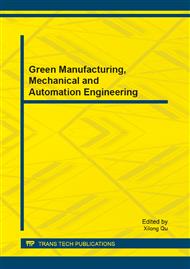p.480
p.484
p.489
p.493
p.497
p.502
p.507
p.512
p.517
Unknown Input and Disturbance Output Reconstruction for a Class of Linear Systems
Abstract:
This paper considers the problems of simultaneous unknown input and disturbance output reconstruction for linear systems. By introducing an augmented vector, an augmented system is constructed. Then, a robust sliding mode observer is proposed to not only estimate the states of the system but also reconstruct the disturbance output vector. A first-order robust exact differentiator which can be used to produce the estimates of the system output derivatives is considered. Based on the robust sliding mode observer and the estimates of the output derivatives, a kind of simultaneous unknown input and disturbance output reconstruction method is developed. Finally, a numerical simulation example is used to show the effectiveness of the proposed methods.
Info:
Periodical:
Pages:
497-501
Citation:
Online since:
July 2013
Authors:
Price:
Сopyright:
© 2013 Trans Tech Publications Ltd. All Rights Reserved
Share:
Citation:


